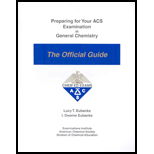
Interpretation:
Whether standard enthalpy of formation of
Concept Introduction:
Standard enthalpy of reaction is calculated by summation of standard enthalpy of formation of the product minus the summation of standard enthalpy of formation of reactants at the standard conditions. The expression to calculate the standard enthalpy of reaction
Here,
m is the
n is the stoichiometric coefficient of reactant.
Answer to Problem 14PQ
Option (A) is the correct one.
Explanation of Solution
Reason for correct option:
The formation of
One mole of
The formula to calculate standard enthalpy of a given reaction
Substitute
The formation of
One mole of
The formula to calculate standard enthalpy of a given reaction
Substitute
The standard enthalpy of formation of
Reason for incorrect option:
Since enthalpy of
Therefore, choice (C), (B) and (D) are incorrect.
The standard enthalpy of formation of
Want to see more full solutions like this?
Chapter EN Solutions
Preparing for your ACS examination in general chemistry
 ChemistryChemistryISBN:9781305957404Author:Steven S. Zumdahl, Susan A. Zumdahl, Donald J. DeCostePublisher:Cengage Learning
ChemistryChemistryISBN:9781305957404Author:Steven S. Zumdahl, Susan A. Zumdahl, Donald J. DeCostePublisher:Cengage Learning ChemistryChemistryISBN:9781259911156Author:Raymond Chang Dr., Jason Overby ProfessorPublisher:McGraw-Hill Education
ChemistryChemistryISBN:9781259911156Author:Raymond Chang Dr., Jason Overby ProfessorPublisher:McGraw-Hill Education Principles of Instrumental AnalysisChemistryISBN:9781305577213Author:Douglas A. Skoog, F. James Holler, Stanley R. CrouchPublisher:Cengage Learning
Principles of Instrumental AnalysisChemistryISBN:9781305577213Author:Douglas A. Skoog, F. James Holler, Stanley R. CrouchPublisher:Cengage Learning Organic ChemistryChemistryISBN:9780078021558Author:Janice Gorzynski Smith Dr.Publisher:McGraw-Hill Education
Organic ChemistryChemistryISBN:9780078021558Author:Janice Gorzynski Smith Dr.Publisher:McGraw-Hill Education Chemistry: Principles and ReactionsChemistryISBN:9781305079373Author:William L. Masterton, Cecile N. HurleyPublisher:Cengage Learning
Chemistry: Principles and ReactionsChemistryISBN:9781305079373Author:William L. Masterton, Cecile N. HurleyPublisher:Cengage Learning Elementary Principles of Chemical Processes, Bind...ChemistryISBN:9781118431221Author:Richard M. Felder, Ronald W. Rousseau, Lisa G. BullardPublisher:WILEY
Elementary Principles of Chemical Processes, Bind...ChemistryISBN:9781118431221Author:Richard M. Felder, Ronald W. Rousseau, Lisa G. BullardPublisher:WILEY





